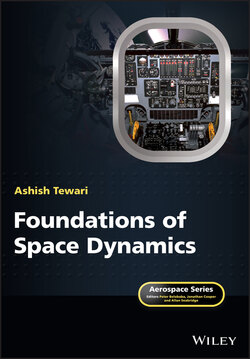Foundations of Space Dynamics

Реклама. ООО «ЛитРес», ИНН: 7719571260.
Оглавление
Ashish Tewari. Foundations of Space Dynamics
Table of Contents
List of Tables
List of Illustrations
Guide
Pages
Foundations of Space Dynamics
Aerospace Series – Recently Published Titles
Preface
1 Introduction
1.1 Space Flight
1.1.1 Atmosphere as Perturbing Environment
1.1.2 Gravity as the Governing Force
1.1.3 Topics in Space Dynamics
1.2 Reference Frames and Time Scales
1.2.1 Sidereal Frame
1.2.2 Celestial Frame
1.2.3 Synodic Frame
1.2.4 Julian Date
1.3 Classification of Space Missions
Exercises
References
Note
2 Dynamics
2.1 Notation and Basics
2.2 Plane Kinematics
2.3 Newton's Laws
2.4 Particle Dynamics
2.5 The n‐Body Problem
2.6 Dynamics of a Body
2.7 Gravity Field of a Body
2.7.1 Legendre Polynomials
2.7.2 Spherical Coordinates
2.7.3 Axisymmetric Body
2.7.4 Spherical Body with Radially Symmetric Mass Distribution
Exercises
References
Notes
Chapter 3 Keplerian Motion
3.1 The Two‐Body Problem
3.2 Orbital Angular Momentum
3.3 Orbital Energy Integral
3.4 Orbital Eccentricity
3.5 Orbit Equation
3.5.1 Elliptic Orbit
3.5.2 Parabolic Orbit
3.5.3 Hyperbolic Orbit
3.5.4 Rectilinear Motion
3.6 Orbital Velocity and Flight Path Angle
3.7 Perifocal Frame and Lagrange's Coefficients
Exercises
Notes
Chapter 4 Time in Orbit
4.1 Position and Velocity in an Elliptic Orbit
4.2 Solution to Kepler's Equation
4.2.1 Newton's Method
4.2.2 Solution by Bessel Functions
4.3 Position and Velocity in a Hyperbolic Orbit
4.4 Position and Velocity in a Parabolic Orbit
4.5 Universal Variable for Keplerian Motion
Exercises
References
5 Orbital Plane
5.1 Rotation Matrix
5.2 Euler Axis and Principal Angle
5.3 Elementary Rotations and Euler Angles
5.4 Euler‐Angle Representation of the Orbital Plane
5.4.1 Celestial Reference Frame
5.4.2 Local‐Horizon Frame
5.4.3 Classical Euler Angles
5.5 Planet‐Fixed Coordinate System
Exercises
6 Orbital Manoeuvres
6.1 Single‐Impulse Orbital Manoeuvres
6.2 Multi‐impulse Orbital Transfer
6.2.1 Hohmann Transfer
6.2.2 Rendezvous in Circular Orbit
6.2.3 Outer Bi‐elliptic Transfer
6.3 Continuous Thrust Manoeuvres
6.3.1 Planar Manoeuvres
6.3.2 Constant Radial Acceleration from Circular Orbit
6.3.3 Constant Circumferential Acceleration from Circular Orbit
6.3.4 Constant Tangential Acceleration from Circular Orbit
Exercises
References
7 Relative Motion in Orbit
7.1 Hill‐Clohessy‐Wiltshire Equations
7.2 Linear State‐Space Model
7.3 Impulsive Manoeuvres About a Circular Orbit
7.3.1 Orbital Rendezvous
7.4 Keplerian Relative Motion
Exercises
8 Lambert's Problem
8.1 Two‐Point Orbital Transfer
8.1.1 Transfer Triangle and Terminal Velocity Vectors
8.2 Elliptic Transfer
8.2.1 Locus of the Vacant Focii
8.2.2 Minimum‐Energy and Minimum‐Eccentricity Transfers
8.3 Lambert's Theorem
8.3.1 Time in Elliptic Transfer
8.3.2 Time in Hyperbolic Transfer
8.3.3 Time in Parabolic Transfer
8.4 Solution to Lambert's Problem
8.4.1 Parameter of Transfer Orbit
8.4.2 Stumpff Function Method
Algorithm No. 1
Algorithm No. 2
8.4.3 Hypergeometric Function Method
Exercises
References
9 Orbital Perturbations
9.1 Perturbing Acceleration
9.2 Osculating Orbit
9.3 Variation of Parameters
9.3.1 Lagrange Brackets
9.4 Lagrange Planetary Equations
9.5 Gauss Variational Model
9.6 Variation of Vectors
9.7 Mean Orbital Perturbation
9.8 Orbital Perturbation Due to Oblateness
9.8.1 Sun‐Synchronous Orbits
9.8.2 Molniya Orbits
9.9 Effects of Atmospheric Drag
9.9.1 Life of a Satellite in a Low Circular Orbit
9.9.2 Effect on Orbital Angular Momentum
9.9.3 Effect on Orbital Eccentricity and Periapsis
9.10 Third‐Body Perturbation
9.10.1 Lunar and Solar Perturbations on an Earth Satellite
9.10.2 Sphere of Influence and Conic Patching
9.11 Numerical Methods for Perturbed Keplerian Motion
9.11.1 Cowell's Method
9.11.2 Encke's Method
Exercises
References
10 Three‐Body Problem
10.1 Equations of Motion
10.2 Particular Solutions by Lagrange
Equilibrium Solutions in a Rotating Frame
Conic Section Solutions
10.3 Circular Restricted Three‐Body Problem
10.3.1 Equations of Motion in the Inertial Frame
10.4 Non‐dimensional Equations in the Synodic Frame
10.5 Lagrangian Points and Stability
10.5.1 Stability Analysis
10.6 Orbital Energy and Jacobi's Integral
10.6.1 Zero‐Relative‐Speed Contours
10.6.2 Tisserand's Criterion
10.7 Canonical Formulation
10.8 Special Three‐Body Trajectories
10.8.1 Perturbed Orbits About a Primary
10.8.2 Free‐Return Trajectories
Exercises
Reference
11 Attitude Dynamics
11.1 Euler's Equations of Attitude Kinetics
11.2 Attitude Kinematics
11.3 Rotational Kinetic Energy
11.4 Principal Axes
11.5 Torque‐Free Rotation of Spacecraft
11.5.1 Stability of Rotational States
11.6 Precession and Nutation
11.7 Semi‐Rigid Spacecraft
11.7.1 Dual‐Spin Stability
11.8 Solution to Torque‐Free Euler's Equations
11.8.1 Axisymmetric Spacecraft
11.8.2 Jacobian Elliptic Functions
11.8.3 Runge‐Kutta Solution
11.9 Gravity‐Gradient Stabilization
Exercises
12 Attitude Manoeuvres
12.1 Impulsive Manoeuvres with Attitude Thrusters
12.1.1 Single‐Axis Rotation
12.1.2 Rigid Axisymmetric Spin‐Stabilized Spacecraft
12.1.3 Spin‐Stabilized Asymmetric Spacecraft
12.2 Attitude Manoeuvres with Rotors
12.2.1 Reaction Wheel
12.2.2 Control‐Moment Gyro
12.2.3 Variable‐Speed Control‐Moment Gyro
Exercises
References
A Numerical Solution of Ordinary Differential Equations
A.1 Fixed‐Step Runge‐Kutta Algorithms
A.2 Variable‐Step Runge‐Kutta Algorithms
A.3 Runge‐Kutta‐Nyström Algorithms
References
B Jacobian Elliptic Functions
Reference
Index
WILEY END USER LICENSE AGREEMENT
Отрывок из книги
First Edition
Ashish Tewari
.....
Thus the translational motion of the body is described by the motion of its centre of mass, as if all the mass were concentrated at that point.
Figure 2.3 A body as a collection of large number of particles of elemental mass, , with centre of mass o.
.....